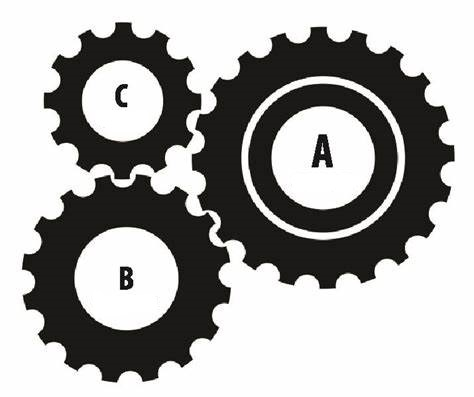Problems
In a distant village, there are \(3\) houses and \(3\) wells. Inhabitants of each house want to have access to all \(3\) wells. Is it possible to build non-intersecting straight paths from each house to each well? All houses and well must be level (that is, none of them are higher up, like on a mountain, nor are any of them on lower ground, like in a valley).
Find all \(n\) such that a closed system of \(n\) gears in a plane can rotate. We call a system closed if the first gear wheel is connected to the second and the \(n\)th, the second is connected to the first and the third, the third is connected to the second and the fourth, the fourth is connected to the third and the fifth, and so on until the \(n\)th is connected to the \(n-1\)th and the first. In the picture, we have a closed system of three gears.

There are various ways to prove mathematical statements. One of the possible methods which might come in handy in certain situations is called proof by contradiction. To prove a statement we first assume that the statement is false and then deduce something that contradicts either the condition, or the assumption itself, or just common sense. Due to the contradiction, we have to conclude that the first assumption must have been wrong, so the statement is actually true.
A closely related method is called contrapositive proof. An example should make the idea quite clear. Consider the statement “if the joke is funny, then I will be laughing". Another completely equivalent way of saying it would be “if I am not laughing, then the joke is not funny". The second statement is known as the contrapositive of the first statement.
We can often prove a statement by proving its contrapositive. Many statements are proven by deriving a contradiction. However, one can often rewrite them as either a direct proof or a contrapositive proof.
Let’s take a look at both of these techniques.
Could you meet a person inhabiting this planet who asks you “Am I a Goop?"
On this planet you meet a couple called Tom and Betty. You hear Tom
ask someone: “Are Betty and I both Goops?"
What kind is Betty?
You learn that one of the aliens living on this planet is a wizard. You learnt that by overhearing a certain question being asked on the planet. What question could that have been?
Suppose you meet a person inhabiting this planet and they ask you “Am I a Crick?" What would you conclude?
You meet two friends, Katja and Anja. Katja once asked Anja “Is at
least one of us a Goop?"
What kinds are Katja and Anja?
You later learn that there is exactly one wizard on this planet of
Cricks and Goops. You would like to find out who that is.
You meet an alien called Andrew. He asks you “Am I the kind that could
ask whether I am not the wizard?"
Do you have enough information to tell for sure who the wizard is by
now?
You meet another alien, whose name is Teddy. He asks you “Am I the
kind who could ask whether I am a Goop?"
Can anything be deduced about Teddy?